Everything you need to get big is sitting in your garage. Lift dirty for strength by repurposing these common building materials, even if you don’t have everything on the list. Most of this material can be purchased for relatively little money at any hardware store. Plus, unlike dedicated fitness equipment in the age of coronavirus, this stuff is always in stock.
The benefits aren’t just financial. Working out with irregular objects forces your body to work more holistically than traditional gym-style weightlifting and more fully translates to athletic movements and the everyday movements that are a part of your life. Follow a building-materials routine, and you’ll appreciate it next time you help a friend move, need to shoulder a heavy bag of dog food, or catch a squirming toddler.
Stones or Cinder Blocks
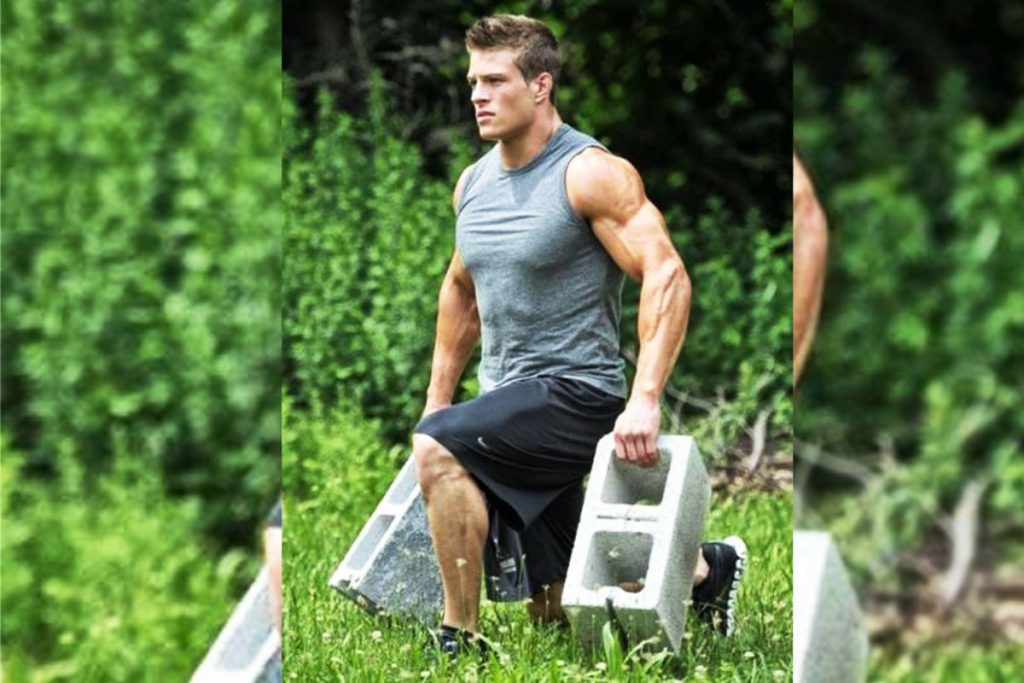
Stone lifting is one of the oldest forms of strength training on record. It is still used today as entertainment in parts of the world and features yearly in world’s-strongest-man competitions.
Exercises: Lifts, shouldering, carries
Stone lifts offer an enormous training stimulus due to the unconventional method of lifting a heavy stone from the ground. The odd shape makes gripping the stone difficult, and its uneven weight distribution forces stabilizing muscles into overdrive in order to focus maximal effort on the lift. These benefits mean huge rewards for those brave enough to give lifting them a shot. Lifting is also necessary in order to perform any of the follow-up movements such as carries or shouldering.
Cues: Adopt a wide stance with the stone between your feet. Find a handhold underneath the stone and drop your hips slightly. Drive through the legs until the stone passes the knees. Once it’s above the knees, squat below the stone and place the stone on your thighs. This is a rest of sorts and offers the chance to change your grip on the stone. A bear-hug grip is often best, but this varies from stone to stone. Once you have regripped the stone it is time to stand tall, pausing with the stone held tightly to your chest. To release the stone, lean forward and let the stone go, making sure your feet are not in the way. Get back into your starting position and begin your next repetition.
Shouldering a stone takes an enormous amount of hip power and a rock-solid core (pun intended). Again, the uneven nature of natural stones forces the body to constantly readjust as you grapple with the weight.
Cues: Begin as above in the stone lift by bringing the stone to your thighs. As you stand with the weight at your abdomen, you must drive your hips forward and up and rotate the stone to your shoulder. Make sure you get your head out of the way, or you will bash your face. Lean forward and drop the stone and begin again, this time to the opposite shoulder.
Sledgehammer
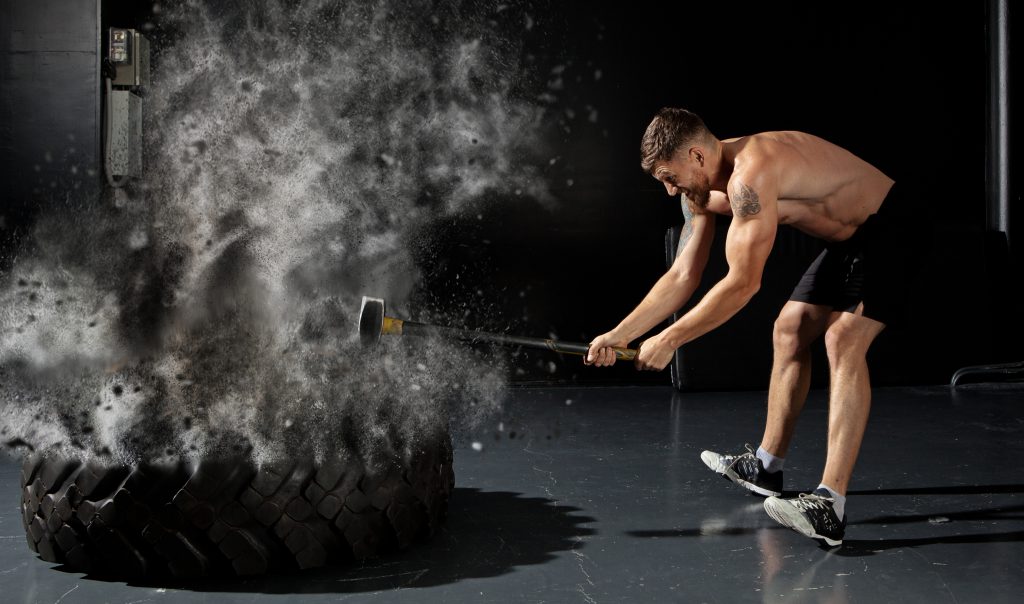
Sledgehammers have been used as a work tool for over 100 years. They are often the first tool that comes to mind when you think of old-school styles of training, and for good reason. Sledgehammers develop huge grip strength, ensure shoulder stability, and push your back and core to their limits.
Exercises: Swings
Sledgehammer swings force your body to work as a unit to develop power from the ground through your hips and back and down your arms to deliver a devastating blow. Sledgehammer swings are best performed on an old tire. The only requirement for the tire is that it must be heavy enough not to bounce off the ground with the force of the blow.
Cues: Adopt a staggered stance with your weak leg in front and strong hand above your weak on the shaft of the hammer, or the reverse, whichever you feel most comfortable with. Swinging the hammer back behind your rear leg initiates the movement. Continue the movement in a large arc until your hands are above your head. From this point you will contract your abs as you bring your arms down to land the blow. Be prepared for the recoil as the hammer bounces off the tire. Reset and begin again. You can also execute these hammer swings with one arm throughout the entire movement, but this will require a much lighter hammer. This will challenge the grip strength of each hand independently and can even out innate strength imbalances.
Sandbag
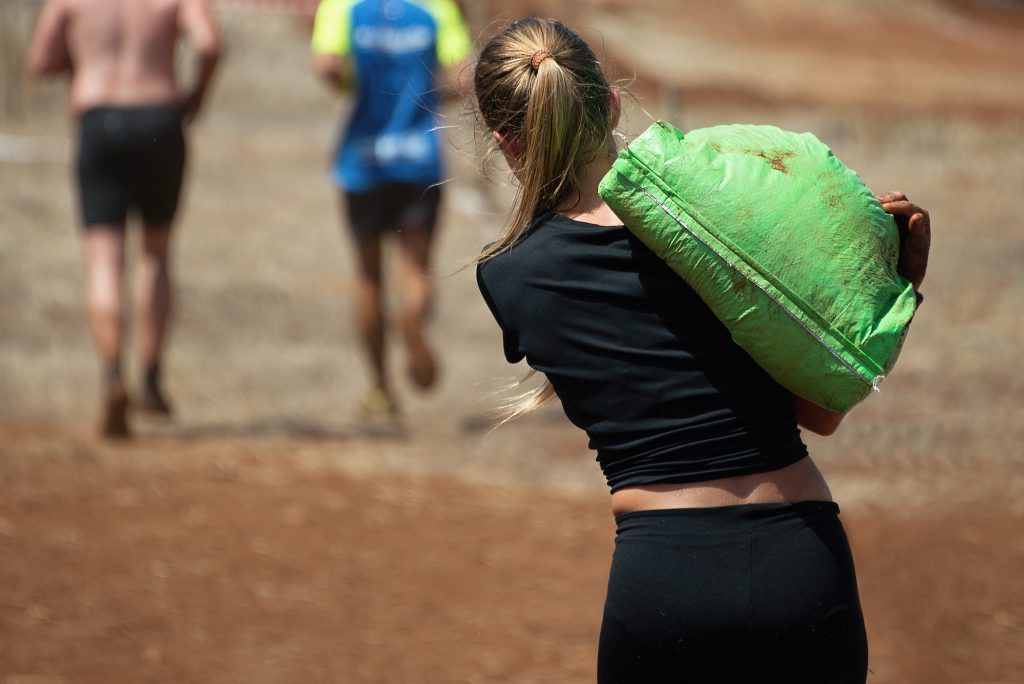
Sandbags have become very popular in the “functional fitness” movement, but it’s nothing new for any military veteran. Sandbags require near constant compensation as the sand inside shifts and slides, resulting in big strength gains and a massive boost to core and stabilizer strength.
Exercises: Cleans (shouldering), presses, bear hugs, shoulder carries, lunges, squats, and more
Sandbag cleans can be a game changer in power development, requiring little more than a sturdy bag and some sand. Shouldering differs from cleans only in the grip that is taken. Cleans are performed by grabbing fistfuls of fabric or using the handles on commercial sandbags. Shouldering is performed by grasping the bag around its middle. Forgo the handles on your commercial sandbag and your grip will become nearly bulletproof. But be careful that the fabric of the bag doesn’t rip your hands up.
Cues: Stand with your feet below your hips and toes at or under the bag. Grasp either the handles or a fistful of the fabric. With eyes ahead, chest up and back set, raise your hips until you feel tension in your hamstrings. Keeping your arms straight, explosively bring your hips up and forward until your hips are fully extended. Flip your wrists and drop below the bag to catch it across both shoulders beneath your chin. Stand tall, drop the bag, and reset for the next rep. Alternately you can start with the bag between your legs, grasp the end of the bag closest to your toes, and flip the bag onto one shoulder and then the other, using the same movement to further challenge your core.
Presses can be performed from the completion of the clean or from a shouldered position, passing the bag overhead to the opposite shoulder with each repetition. A true test of shoulder strength and stability, the sandbag press is an easy way to build strength and power in your shoulders, upper back, and throughout your core.
Cues: From a finished clean position or with the bag resting on one shoulder, place your hands on the bag to balance the load. Driving your feet into the ground, press the bag overhead until your arms are fully extended in the “lockout” position. The only difference between the one-handed and the two-handed variants is that you will lower the bag to the opposite shoulder for each rep in the alternating one-handed shoulder press.
Once you master shouldering the sandbag, a host of new exercise opportunities are available to you. With weight balanced only on one side of your body, your core must work overtime in order to maintain correct posture throughout the movements. From a shouldered position you may perform carries, squats, lunges, and many of their variants.
Logs
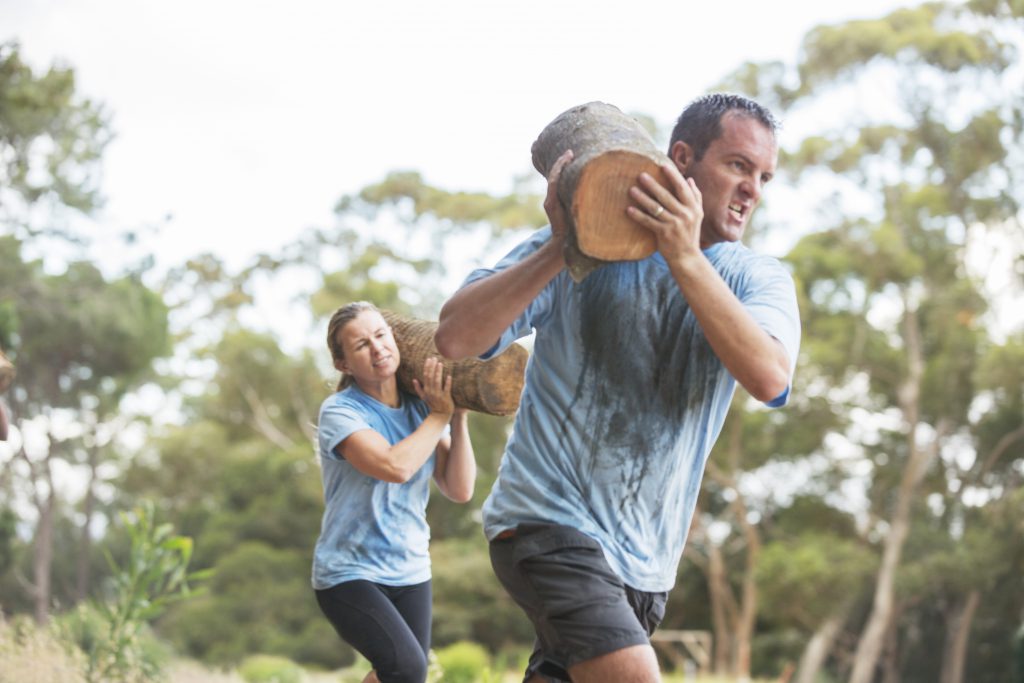
Wooden logs are deceptively heavy, and their inconsistent size across their length means that the weight is not evenly distributed. This poses unique challenges to the body as you attempt to work with them. This imbalance forces better body awareness and can lead to big strength gains.
Exercises: Cleans (shouldering), presses, shoulder carries, lunges, squats, and more
Shouldering a log is performed much as shouldering a stone is above. You must grasp the log around its girth and drive the log onto one shoulder, flipping it end-over-end while ensuring your hands are placed in a position to balance the load.
A feature of the Arnold Strongman Classic every year, log presses are a time-honored display of strength. Pressing a log overhead is an impressive feat to be sure and requires an immense amount of balance, stability, and strength to accomplish. Logs are very difficult to hold with only your hands. This difficulty translates to big benefits when you’re lifting the weight overhead.
Cues: You must first clean or shoulder the log as above. From here you may opt to attempt to rotate the log across your shoulders, or you may begin the press from one side. Driving into the ground, press both hands toward the sky, balancing the log throughout the movement. Once your arms are locked out straight, bring the log to the other shoulder and begin the next repetition.
Cues: Lifting a log follows the same procedures for sandbag lifts with the exception that how you place your hands will be different as you work to balance the log overhead. The alternating shoulder press is the best place to start, as the grip in this variant is more straightforward.
Shouldering a log is more cumbersome than a sandbag and infinitely less comfortable. Logs are unruly, hard, and difficult to manage. But this should not dissuade you from working with them, as they offer benefits unattainable with other movements in this list. Once you master shouldering, squats, lunges, and carries are again open to you and present a host of new challenges.
Tires

There is something primal about exerting your will on a seemingly immovable object, like a giant tire. Tractor tires can often be had for free and offer a number of benefits. Not only will they provide you the perfect place to execute sledgehammer swings — they also open up exciting new movements that will challenge your explosive strength and endurance.
Exercises: Tire flips, tire jumps
Tire flips are a very unassuming movement, but don’t be fooled by watching experts manhandle these giant implements. Tire flips require an enormous amount of power and coordination and will challenge you from head to toe.
Cues: Approach the tire and make sure there is no water inside (you will thank me later). Slide your hands beneath the tire, adopting a stone lifting posture as noted above. Keeping your chest pressed tightly against the tire, explode up and forward with straight arms. Slide one knee underneath the tire and take a slight rest as you adjust your hands. Place the palms of your hands against the tire, fingers to the sky. With your hands in place, drive against the ground and shove the top of the tire away from you. When it flips, you have completed one repetition. Reset and get ready for the next.
Tractor tires are tall and so can be used to execute box jumps as a standalone exercise or, if you are on the nutty side, after each tire flip for an added jolt to your routine or level of toughness. This further pushes your power levels skyward and will keep you at the redline.
Cues: Approach the tire, pause, and leap onto the tire by quickly flexing and extending your hips. Alternatively, you can leap from within the tire, landing with your feet in a lunge position or a wide squat position on opposite sides of the opening.
Buckets
A 5-gallon plastic bucket can be had for a few dollars and be filled with water, sand, stones, or anything you can find. Water offers the least stable weight as it sloshes from side to side throughout the movement, requiring a ton of work from your stabilizers and core. Make sure you get the lids as well to allow for more variation in your workouts.
Exercises: Carries, presses (keg lifts)
Carrying a weight in front of your body places an enormous load on the muscles of your back as you squeeze the weight to your body. You will find your lower back screaming after carrying this load for a distance.
Cues: Pick up the bucket filled with your preferred medium at a challenging weight. Reaching around the bucket, grab the bottom lip in the front of the bucket. Alternatively, you may opt for a bear-hug approach. With the weight settled in front of you, begin moving at a designated pace (walk, run, jog, etc.) for the designated distance.
Read Next: Lift Dirty: How to Program for Results

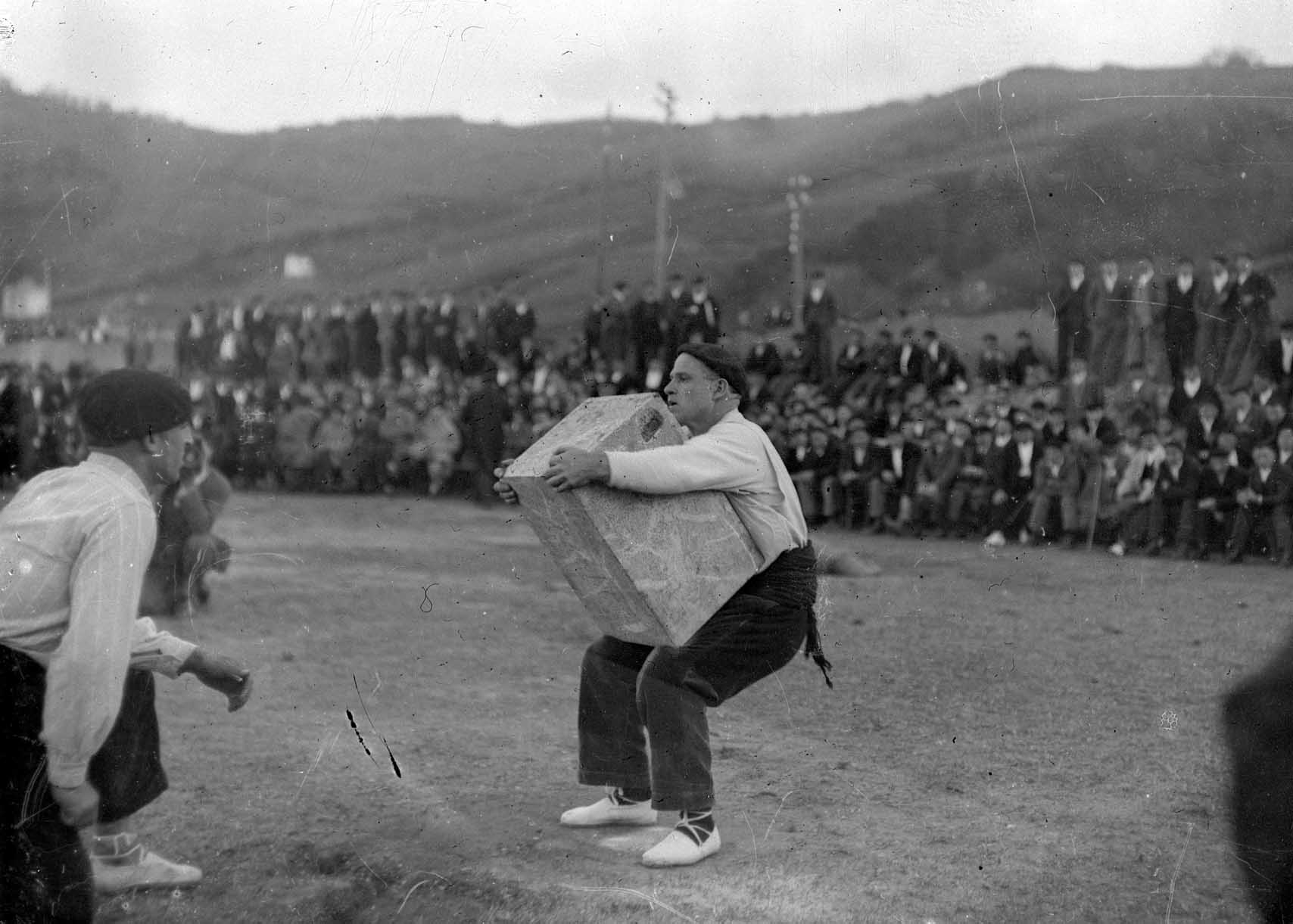






Comments